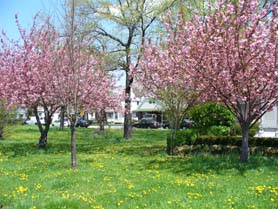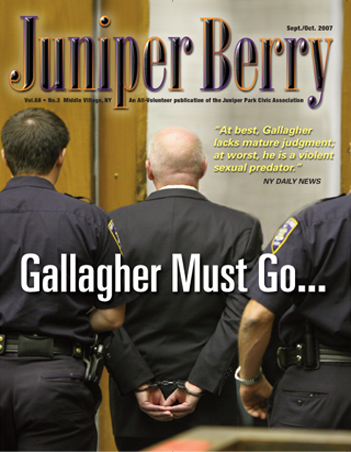The City of New York Department of Parks & Recreation has jurisdiction over all trees growing in the public right-of-way, including trees along streets, parkways, and in city parks.
An actual count of NYC trees by the Department of Parks was done in the 2005-2006 Street Tree Census and revealed that there are 592,130 street trees – a 19% increase over the number counted during the 1995-1996 census. Mayor Bloomberg has started an initiative to plant 1,000,000 additional trees in NYC by the year 2030.
There are two ways to have a tree planted in front of your property. The first option for planting trees is to contact your local community board, which submits a list of tree requests twice a year to the Parks Department. A request form signed by the property owner is necessary in order to receive a tree. Trees are planted on a first-come, first-serve basis. Since the demand for trees is so great there may be a one to two season lag time between the request and the planting.
It will come as no surprise to anyone to read that the City is very protective and fussy about their street trees and getting caught damaging a tree has some very dire consequences.
To give you an idea of how serious and protective the NYC Parks Department is of their trees, I remember about 35 years ago, my elderly neighbor was caught cutting branches from his street tree and he was fined $1,000! He was shocked and upset and eventually he pled down the fine but nevertheless the message was clear, you don’t mess with NYC trees!
Regulations are noted in several sources, including the City Charter, sections of the Administrative Code, and Parks Rules & Regulations. Any person wishing to do work on or around street trees must first obtain a permit from their Parks borough forestry office. This includes pruning, fertilizing, spraying for the control of insects and disease, planting, installing decorative lights, tree grates and/or tree guards, and removing or relocating an existing tree. Those failing to obtain appropriate permits before beginning tree work may be subject to arrest and prosecution under the New York City Administrative Code and New York City Rules. Most violations are misdemeanors, punishable by a fine of up to $1,000 and/or imprisonment up to 90 days. Removing a tree without a permit or damaging a tree are very serious offenses punishable by fine of up to $15,000 and/or imprisonment for up to one year.
The following tips help curb the illegal cutting of street trees:
1) If you think a street tree is in danger, take a photo of it. This will serve as a “before” photo, a valuable piece of evidence.
2) If you see someone cutting down a tree illegally, call 311. Parks Police Officers have the power of arrest and will be dispatched to the scene.
3) Write down the name and address of the contractor removing the tree, if available (it may be on the construction fence or truck), and take a photo of the crime in progress. The officers will use these to track down the offenders if they have left the scene.
4) You may be asked to sign an affidavit of what you saw if the perpetrators were gone upon the officers' arrival. Your name does not appear on it and you just have to sign your initials. The officers will visit you at home; you won't even have to go to their headquarters. This document may be used in court. You may also be asked to testify in person, but this very rarely happens because most people practicing arboricide are developers who usually do not bother to show up to fight the fines.
Currently the free sidewalk repair program is still in effect and that means that if you call 311 and report a street tree near your house that has damaged the sidewalk the Parks Department will give the damage a rating and then according to severity they will come to repair your sidewalk without touching the tree root. They did my sidewalk in the past year. I had a rating of about 85, which meant considerable sidewalk damage. The Parks Department repaired the sidewalk using a slight hill effect at the point of the root. Actually they did a nifty job, much to my surprise. This is a good program and if you have a problem tree and sidewalk, call 311 and get on the list.
Tree plantings are done from mid-October through mid-December or during the spring in mid-March through mid-May. They do not plant any other times of the year. The average wait for a street tree is around 6 months depending on when the applications are received. The deadline for receiving fall planting applications is June 30 and spring planting is December 31.
The Forestry Department has the following criteria for new plantings:
• trees are not planted in front of building entrances or within a bus stop.
• the minimum distance between trees is 20' to
40' depending on tree size.
• the minimum distance from a street light or a telephone pole is 25' and varies with species.
• the minimum distance from a stop sign is 30'.
• the minimum distance from a traffic signal is 6'.
• the minimum distance from a hydrant is 5'.
• the minimum distance from a driveway is 7'.
• the minimum distance from an intersection is 40'.
The Forestry Department also does not plant near underground water mains, gas lines and electrical lines, which are usually marked out on the street and sidewalk (water is blue or white, gas is yellow and electric is orange). Trees must stay away from these utilities at all times, there are no exceptions.
It also is not wise to request that a tree be planted under overhead power or telephone wires. They almost always get tangled in the wires as they grow and require frequent pruning, which may eventually result in their demise.
Parks is also now only planting trees that are resistant to the Asian Long-horned Beetle, as part of the effort to eradicate this invasive species. Examples of acceptable species are Dawn Redwood, Turkish Filbert, honey locust, oaks, and lindens. The beetles are known to attack maple, horse chestnut, elm, willow, birch, poplar, and ash trees, so unfortunately planting these beautiful species must be avoided until further notice.
If there is a large dead tree or stump in the location of where a tree is requested, Queens Forestry must first remove the stump or tree before a new tree can be planted.
If you have any questions about street trees always start at 311. The information you receive is usually current and helpful and 311 operators can walk you through the process of solving any of your tree problems.



